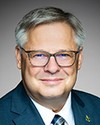Thank you.
I thank the committee for undertaking this study and for inviting me to speak to you about science and research needs in Canada's Arctic.
My name is Kimberly Strong. I'm a professor and the chair of the department of physics at the University of Toronto. I'm also an atmospheric scientist and the principal investigator of PEARL, the Polar Environment Atmospheric Research Laboratory. My group has been doing research at this location for 25 years.
I'm speaking on behalf of the PEARL science team, which includes colleagues from nine universities. We also have many partners across Canada and internationally, and we work closely with Environment and Climate Change Canada and the Canadian Space Agency. Work at PEARL is conducted under a scientific research licence from the Nunavut Research Institute.
The Arctic remains one of the earth's least understood environments, and yet it is a bellwether for climate change, a receptor for global pollution and a driver for the global climate system. Northern ecosystems, including ice, snow and permafrost; wildlife and vegetation; and marine systems are all linked together by our atmosphere. It contains the air we breathe and the protective ozone layer, it stores greenhouse gases, it's where weather happens, and it transports air pollution and wildfire smoke into the Arctic.
PEARL is a flagship observatory established in 2005 for tracking changes happening in the Arctic atmosphere and for determining the causes and global impacts. PEARL is located at 80° north on Ellesmere Island near the Environment and Climate Change Canada weather station at Eureka, Nunavut. For nearly 20 years, PEARL measurements have provided insight into an array of scientific policy and societal issues that are relevant to Arctic communities, Canada and the world.
PEARL's focus on long-term atmospheric measurements in the very High Arctic differentiates it from the research activities of the Canadian High Arctic Research Station at Cambridge Bay, from ArcticNet, from the Centre for Northern Studies, and the Amundsen icebreaker. We're all complementary in what we do.
PEARL is an important Canadian station in five international observing networks. As the most northerly permanent station for most of these networks and one of only a few in the Arctic, PEARL measurements fill a very large gap in their geographical coverage. PEARL is also a key site for verifying the data from satellite missions, including the upcoming high-altitude aerosols, water vapour and clouds mission, which will be Canada's contribution to NASA's multi-decadal atmosphere observing system.
PEARL offers exceptional educational opportunities and has trained more than 100 students, postdoctoral fellows and technical staff, most of whom are now working in government, academia and industry. Our outreach program has been active in six northern Nunavut communities through school visits, student researcher collaborations, and workshops for teachers.
PEARL is remote and isolated, accessible only by charter aircraft and the annual summer ship visit. The nearest community, Grise Fiord, is more than 400 kilometres to the south by air. PEARL is very different from a normal campus-based lab or facility located in a community.
The December 2023 report of the expert panel on the future of Arctic northern research in Canada highlighted PEARL as a unique and internationally important research facility. The report stated that “even where infrastructure is remote and where there are no nearby communities with which to partner, facilities such as [PEARL] represent critical elements of an effective research system and cannot go overlooked.”
Over the last 18 years, Canada has invested in PEARL infrastructure, operations, science and training. However, this investment is now at risk. PEARL needs stable funding that's attuned to being a unique facility in a unique location. Unfortunately, PEARL does not fit easily into any of Canada's major recurring funding programs. Many of the programs that previously supported PEARL no longer exist, and PEARL's last major grant ended in 2021. PEARL is currently running at a minimal level and will close this year if new funding is not secured soon.
Let me summarize my remarks with reference to the three points being assessed by the committee's study.
Number one, to understand the consequences and impacts of environmental change, we need to track changes over time. We need a long-term strategy for supporting Arctic research in Canada—a strategy that's inclusive of different approaches, including both indigenous and western science; a strategy that encompasses the many different components of the Arctic ecosystem, including the atmosphere, which sometimes gets left out; and a strategy that engages and reflects the needs of local, regional, territorial, national and international partners.
Number two, to fully participate in research, Arctic and northern populations need access to infrastructure, tools and funds. This is true of Arctic research in Canada generally. PEARL is just one example of a facility that's under pressure due to the lack of continuity and sustained operational funding. Establishing research capacity is a huge effort with long lead times. Losing that capacity can happen all too easily. We need sustained funding programs that recognize that research in the Arctic is challenging and expensive, and it should not have a one-size-fits-all model. It should be recognized that not all Arctic research is conducted in communities.
Finally, number three, collaboration with local and indigenous communities is vitally important. However, factors like distance, travel costs and the effort involved in establishing and then sustaining those partnerships present barriers to meaningful collaboration.
This is even more difficult for facilities like PEARL, which don't have the advantage of being located near a community. We need mechanisms to bring together researchers and community members to build co-operative partnerships for long-term and sustainable Arctic research.
Thank you, again, for this opportunity to address the committee.










